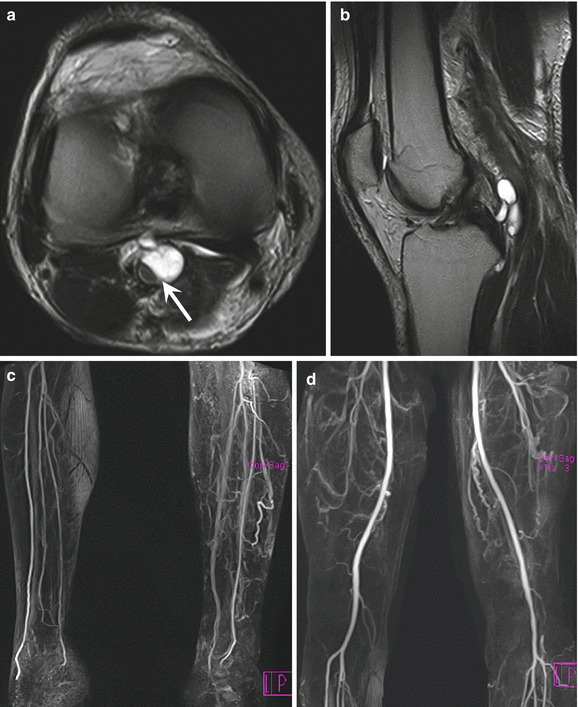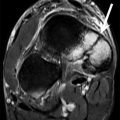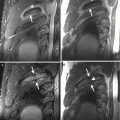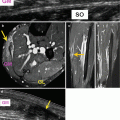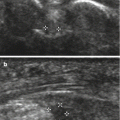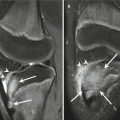Fig. 21.1
A 46-year-old male triathlete, who recently started swimming. Coronal fat-suppressed proton density-weighted MRI shows subacromial bursitis (arrow) and biceps tendinopathy (arrowheads)
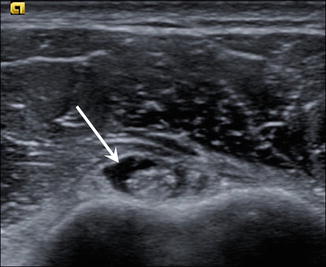
Fig. 21.2
A 23-year-old elite male triathlete after strenuous swimming training. Transverse ultrasound image of biceps tenosynovitis shows hypoechoic fluid (arrow) surrounding the echogenic biceps tendon in the bicipital groove
Glenohumeral instability, also known as multidirectional instability, can cause significant shoulder pain in swimmers. Imaging has a limited role in the diagnosis of this condition (Bales and Bales 2012; Reuter et al. 2008).
Acromioclavicular (AC) osteoarthritis may occur due to overuse or secondary to previous acute trauma to the acromioclavicular joint and may result in chronic shoulder pain (Fig. 21.3). Osteolysis of the distal clavicle may be seen as a complication of AC joint synovitis (Bales and Bales 2012). Ultrasound-guided drug injections of the AC joint and subacromial bursa may be indicated as an adjuvant to conservative management, where it may accelerate rehabilitation and healing (Fig. 21.4) (Bak 2010).
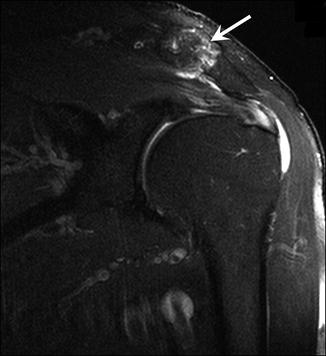
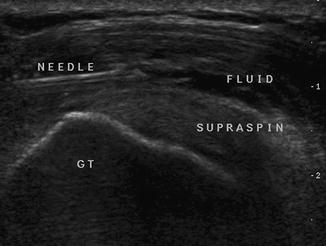

Fig. 21.3
A 46-year-old triathlete with subacromial bursitis and advanced supraspinatus tendinosis. Coronal fat-suppressed proton density-weighted MRI demonstrates acromioclavicular joint arthritis (arrow)

Fig. 21.4
A 28-year-old female triathlete with shoulder pain after a significant increase in swimming distance. Longitudinal ultrasound-guided injection of the subacromial bursa. Supraspin supraspinatus, GT greater tuberosity
21.2.1 Thoracic Outlet Syndrome
Thoracic outlet syndrome is a neurovascular syndrome, a result of compression of the brachial plexus and subclavian vasculature in the region of the thoracic outlet. Arterial, venous, and neurogenic types have been described. Compression of the brachial plexus is by far the most common, occurring in approximately 95 % of cases (Eliahou et al. 2012). In triathletes compression syndromes are often associated with muscular hypertrophy caused by swimming. Predisposing factors include anatomic variants or deformity due to previous trauma such as clavicular or first rib fractures (Eliahou et al. 2012; Demondion et al. 2006). No single imaging modality has proven to be superior in making the diagnosis, and often a combination of modalities is required. Plain radiography may demonstrate underlying bony abnormalities, e.g., cervical ribs. Duplex Doppler ultrasound has the advantage of demonstrating dynamic vessel compression during arm maneuvers. Computed tomography angiography is excellent for demonstrating vascular and bony abnormalities. Conventional MRI may show an abnormally enlarged scalenus muscle. MR angiography has excellent soft tissue contrast resolution, being able to demonstrate muscular and fibrous abnormalities. MR neurography is excellent for evaluating the brachial plexus (Eliahou et al. 2012; Demondion et al. 2006; Francke and Cotten 2000; Remy-Jardin et al. 2000; Smedby et al. 2000).
21.2.2 Paget-Schroetter Syndrome
Also known as effort thrombosis, Paget-Schroetter syndrome is a subtype of venous thoracic outlet syndrome, usually as a result of overhead arm physical activity. It is most common in young male athletes. There is compression of the subclavian vein at the costoclavicular junction, with resultant venous damage and eventually venous thrombosis (Fig. 21.5) (Eliahou et al. 2012; Shebel and Marin 2006; Urschel and Razzuk 2000).
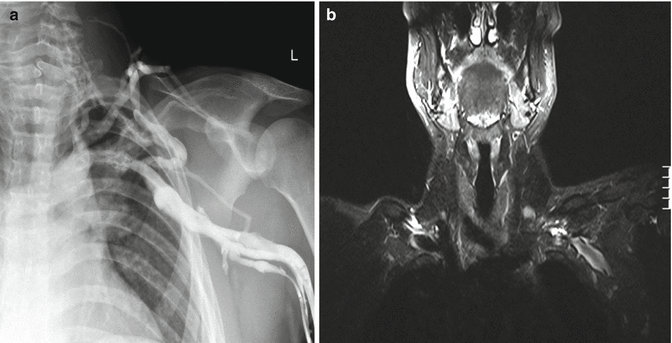

Fig. 21.5
A 26-year-old female elite triathlete with pain and symptoms most marked with swimming. (a) Digital subtraction conventional venogram demonstrating acute stenosis at the junction of the left axillary and left subclavian veins at the level of the first rib. (b) Coronal MR venogram confirms an acute stenosis at the junction of the left axillary and subclavian veins. No external cause could be identified in this case
21.3 Elbow and Wrist
The use of traditional handle bars results in compressive forces on the wrist in an extended position. This may result in ulnar nerve compression and a condition similar to carpal tunnel syndrome. Motor and sensory deficits are more common in the ulnar than the median nerve distribution (Deakon 2012; Akuthota et al. 2005).
21.3.1 De Quervain Tenosynovitis
De Quervain tenosynovitis is the most common tendinopathy of the wrist in athletes. It is caused by a shearing stress injury of the first extensor compartment tendons along the radial styloid. Repetitive wrist motion with radial or ulnar deviation and flexion or extension may result in tenosynovitis or even tearing of the extensor pollicis brevis and abductor pollicis longus tendons (Bancroft 2013; Davis and Blankenbaker 2010).
21.3.2 Intersection Syndrome
Two types of intersection syndrome have been described. The first is an overuse injury as a result of repetitive microtrauma. The condition is also known as oarsmen’s wrist, squeaker’s wrist, or crossover syndrome (Bancroft 2013; Lee et al. 2009). MRI demonstrates peritendinous edema of the first and second extensor compartment tendons (abductor pollicis longus and extensor pollicis brevis) in the distal forearm as they cross over each other, hence the term crossover syndrome. Distal intersection syndrome results in peritendinous edema of the second and third extensor compartment tendons as they cross over each other (Fig. 21.6) (Bancroft 2013; Parellada et al. 2007).
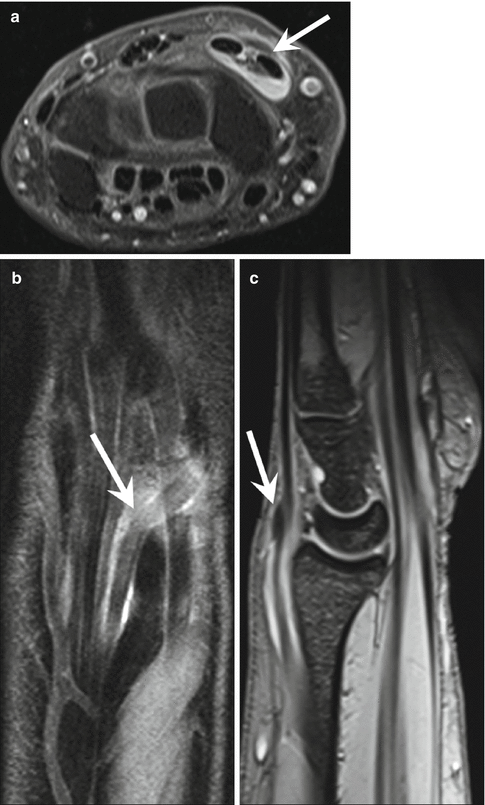

Fig. 21.6
A 28-year-old female elite triathlete. (a) Axial fat-suppressed proton density-weighted MRI demonstrates fluid (arrow) surrounding the extensor carpi radialis (ECR) tendons, where the abductor pollicis longus (APL) and extensor pollicis brevis cross the ECR tendons. This was thought to be secondary to the use of triathlon bars for extended periods of time. (b) Coronal fat-suppressed proton density-weighted MRI shows the “crossing over” of the APL over the ECR tendons (arrow). (c) Sagittal DESS MRI shows the site of tendon crossover (arrow)
21.4 Lower Back and Neck Pain
It has been reported that 78 % of triathlon athletes have back and/or neck overuse injuries during a single year (O’Toole et al. 1989). Lumbar pain usually occurs due to a prolonged aerodynamic flexed position during cycling. In three-quarters of athletes, the pain is muscular or ligamentous in nature and temporary. A quarter of athletes experience pain due to disk, facet, or unrecognized spondylosis (Tuite 2010). Symptoms may be aggravated by running. Recommended treatment is to avoid prolonged static hand positions and to use cushioned gloves and handle bar tape. A prolonged period of time on aerobars results in forearm compression and may become painful. To address this, custom fitting of foam and gel supports as well as a gradual increase in duration of exercise time may improve tissue tolerance to compressive forces.
Neck pain is more common in single-sport athletes but is described in approximately 45 % of triathletes. It usually occurs due to prolonged hyperextension during cycling. It is usually muscular in nature (Tuite 2010).
MRI is usually only indicated if the athlete experiences symptoms of cervical or lumbar radiculopathy.
21.5 Upper Leg, Hip, and Groin
Hip injuries in triathletes reportedly account for between 5 and 20 % of all injuries. Hip injuries are mostly associated with running, although cycling may also account for or exacerbate a number of conditions (Spiker et al. 2012).
21.5.1 Hip Bursopathy
Three bursal groups are found about the hip: the trochanteric, ischiogluteal, and iliopsoas bursae. The trochanteric bursa consists of the subgluteus maximus, subgluteus medius, and subgluteus minimus bursae. Hip bursopathy is also known as greater trochanteric pain syndrome as the trochanteric bursa is most commonly affected. It is often associated with gluteus medius and minimus tendinopathy. It is more commonly seen in women, likely because of the wider pelvis in women. Running on a cambered road, an unusually prominent trochanter and excessive adduction are further risk factors. MRI demonstrates fluid distention of the bursae. Signs of inflammation and/or hemorrhage include synovial thickening, internal debris, septations, and fluid-fluid levels (Fig. 21.7) (Spiker et al. 2012; Pan and Bredella 2013; Cho et al. 2004).


Fig. 21.7
Chronically distended trochanteric bursa (calipers) in an elderly female triathlete training for a long distance triathlon. Longitudinal ultrasound image shows intact gluteus medius tendon inserting onto the greater trochanter. Patient responded well to ultrasound-guided injection and hip abductor strengthening exercises
21.5.2 Snapping Hip Syndrome
Snapping hip syndrome is also known as coxa saltans, iliopsoas tendinopathy, or dancer’s hip. It presents as an often painful snapping sensation and/or audible snapping sound that occurs at the hip during a specific motion. It is more common among younger athletes. External and internal types have been described (Spiker et al. 2012). External snapping hip syndrome is caused by either the iliotibial band, tensor fascia lata, or tendon of the gluteus maximus muscle rapidly sliding over the greater trochanter. External snapping is often a clinical diagnosis and rarely requires imaging. Internal snapping hip syndrome is more complex and may occur when the iliopsoas tendon slides over the iliopectineal eminence, femoral head, lesser trochanter, or the anterior hip capsule. It may also occur when the biceps femoris tendon slides over the ischial tuberosity or the iliofemoral ligament slides over the femoral head (Pan and Bredella 2013). Ultrasound is the investigation of choice for dynamic evaluation of the iliopsoas tendon in internal snapping. It is seen as a sudden lateral-to-medial movement of the tendon as it passes over the iliopectineal eminence. Ultrasound can also be used as a therapeutic modality for guided injection of a combination of a local anesthetic agent and a corticosteroid into the iliopsoas bursa (Deslandes et al. 2008; Pelsser et al. 2001). Further causes of internal snapping include labral tears, intra-articular loose bodies, synovial osteochondromatosis, and fracture fragments all of which can be well evaluated by means of arthrographic MRI (Fig. 21.8) (Spiker et al. 2012; Pan and Bredella 2013).
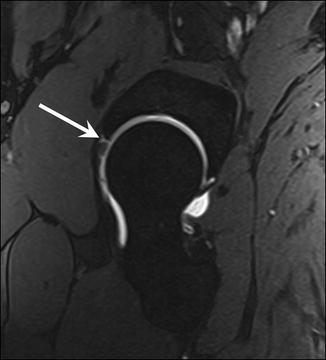

Fig. 21.8
A 28-year-old male elite triathlete with symptoms worst during cycling, especially during the aerodynamic position on the time trial bike. Sagittal post-arthrographic DESS MRI shows contrast intravasation into a tear of the anterosuperior labrum (arrow). A hip arthroscopy with repair of the tear was performed, with a satisfactory outcome
21.5.3 Piriformis Syndrome
Piriformis syndrome is still a poorly understood clinical entity. Patients present with isolated sciatic pain affecting the buttock with radiation to the upper thigh, but without sensory fallout. Described radiological features include piriformis muscle hypertrophy and an anomalous course of the S2 nerve root, most notably an intramuscular course traversing through the piriformis muscle. There is also a lack of more common causes of sciatica such as lumbar disk herniation (Russell et al. 2008; Lee et al. 2004; Papadopoulos and Khan 2004). Image-guided injection of the piriformis muscle initially with air (marker) followed by local anesthetic and cortisone can be used as a diagnostic test. If successful, intramuscular injection of Botox has shown good medium term results as the abnormal piriformis muscle atrophies (Fig. 21.9) (Filler et al. 2005).
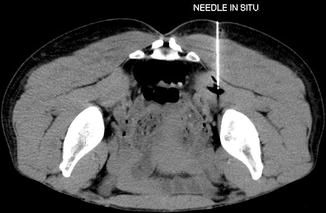

Fig. 21.9
A 40-year-old female semiprofessional triathlete with piriformis syndrome and left-side radiculopathy. Axial prone CT-guided infiltration image of the pelvis demonstrates asymmetric enlargement of the left piriformis muscle. Percutaneous needle placement was performed under CT guidance with the tip visible in the piriformis muscle belly. Air was instilled, visible at the needle tip and dissecting along the intramuscular planes. The patient experienced rapid improvement of symptoms and remains asymptomatic
21.5.4 Osteitis Pubis
Osteitis pubis is part of the entity known as athletic pubalgia (Galloway 2013; Lovell et al. 2006). It occurs as a result of repetitive vertical shearing forces across the pubic symphysis (Tuite 2010). MRI demonstrates bone marrow edema at the pubic symphysis. It may be associated with adductor tendinopathy, posterior abdominal wall weakness, and incipient inguinal hernia (Gilmores groin) (Fig. 21.10) (Tuite 2010; Galloway 2013; Lovell et al. 2006).
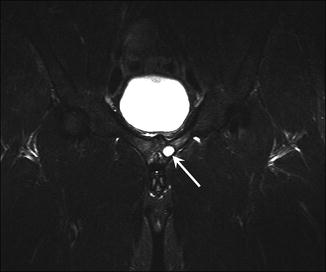

Fig. 21.10
A 30-year-old triathlete presented with chronic groin pain, most severe with running. Coronal STIR MRI of the pelvis shows bilateral bone edema of the pubic bones and an intraosseous cyst (arrow) in the left body of the pubis. Hyperintense signal is also present at the insertion of the left adductor muscle group, representing adductor tendinopathy/insertional enthesopathy, which form a part of the condition known as athletic pubalgia
21.5.5 Cyclist’s Nodule
A cyclist’s nodule represents a focal mass-like lesion of the perineum associated with cycling. It is also known as a biker’s nodule or third testicle (Van de Perre et al. 2009). It is characterized by focal fibroblastic and myofibroblastic proliferation and myxoid degeneration of adipose and collagenous tissue overlying the ischial tuberosities, resulting from pressure, friction, and vibration between the tuberosities and the bike saddle (McCluggage and Smith 2001). Ultrasound demonstrates a hypoechoic hypovascular superficial soft tissue nodule of the perineum. Small focal internal cystic areas may also be present. MRI shows a hypointense, irregular, non-enhancing lesion in the subcutaneous fat (Fig. 21.11) (Van de Perre et al. 2009).
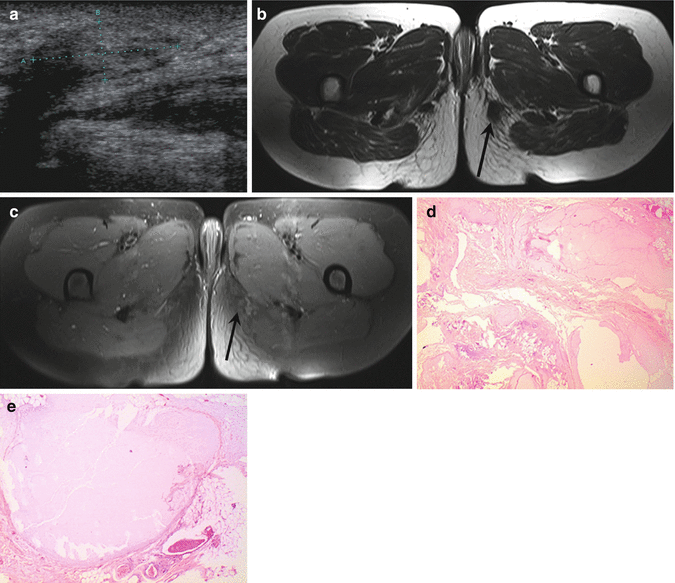

Fig. 21.11
A 32-year-old female triathlete. (a) Parasagittal ultrasound image of the left perineal region demonstrates a well-circumscribed iso- to hypoechoic mass lesion in the superficial soft tissues (calipers). There was no increased intralesional flow on ultrasound Doppler examination (not shown). (b) Axial T1-weighted image of the perineal region demonstrates a homogeneously hypo- to isointense lesion in the medial perineal soft tissues (arrow). (c) Axial fat-suppressed proton density-weighted MRI of the perineal region demonstrates a homogeneously hypo- to isointense lesion in the medial perineal soft tissues (arrow). (d, e) At histology the lesion consisted mainly of fibrotic tissue, edema, and cystic spaces, compatible with a cyclist’s nodule
21.6 Knee
The knee is the most common site for overuse injuries in runners. It accounts for approximately 25–30 % of injuries among triathletes (Clements et al. 1999). Common overuse injuries around the knee include patellar tendinopathy, patellofemoral stress syndrome, and iliotibial band friction syndrome (Tuite 2010; Burns et al. 2003; Taunton et al. 2002). These conditions can all be caused by excessive running and aggravated by both running and cycling (Sanner and O’Halloran 2000).
21.6.1 Patellar Tendinopathy
Patellar tendinopathy is also known as jumper’s knee. It usually presents with acute onset anterior knee pain during running and cycling. During cycling, the high extension forces during the down stroke places strain on the patellar tendon. It often occurs due to a low cadence with high resistance, associated with hill climbing and cycling while standing (Bailey et al. 2003). Tendinopathy usually occurs at the proximal enthesis (Tuite 2010; Deakon 2012; Ostlere 2013). Ultrasound is the initial imaging modality and shows a hypoechoic focus in the tendon. There is usually associated increased echogenicity in the adjacent Kager fat pad. The abnormal focus of tendinosis may demonstrate increased Doppler signal, in keeping with neovascularization. MRI reveals thickening of the tendon with increased signal intensity on fluid-sensitive sequences. Bone marrow edema may be present in the inferior pole of the patella (Fig. 21.12) (Ostlere 2013).
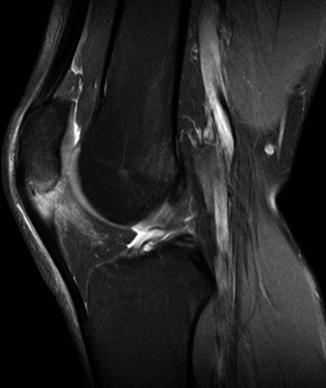

Fig. 21.12
A 30-year-old Xterra triathlete. Sagittal fat-suppressed proton density-weighted MRI of the knee shows marked expansion as well as increased signal intensity in the proximal patellar tendon. There is associated bone marrow edema of the inferior patellar pole with soft tissue edema present in the Hoffa fat pad. Features represent infrapatellar tendinosis
21.6.2 Patellofemoral Stress Syndrome
Patellofemoral stress syndrome is also called runner’s or biker’s knee (Tuite 2010; Ostlere 2013). Causes are multifactorial and usually include a combination of overuse, trauma, and abnormal biomechanics. It is described more often in female athletes. It is postulated that the latter is due to a greater Q angle resulting in an increase in the lateral displacement forces and patellar maltracking. Excessive load is placed on the patellofemoral joint. X-rays may be normal or may demonstrate a patella alta, lateral subluxation of the patella, and/or features of trochlear dysplasia. Quadriceps muscle imbalance with relative deficiency of the vastus medialis obliquus muscle group may be a further etiological factor. MRI is the investigation of choice to assess the patellofemoral chondral surfaces. Chondral degeneration, delamination, chondral defects with a bone stress reaction, and eventually patellofemoral osteoarthrosis may occur (Figs. 21.13 and 21.14) (Ostlere 2013).
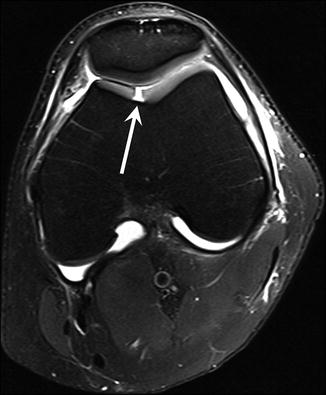
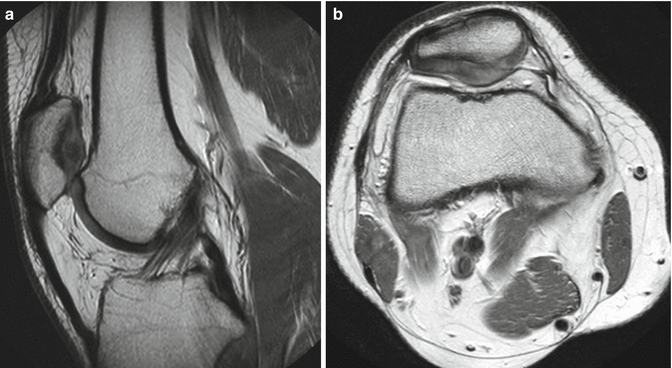

Fig. 21.13
A 29-year-old female Xterra triathlete. Axial fat-suppressed proton density-weighted MRI shows a full-thickness chondral lesion of the femoral trochlea (arrow)

Fig. 21.14
A 22-year-old elite triathlete. (a) Sagittal proton density-weighted MRI shows trochlear dysplasia and patellar chondral blistering. Symptoms were worst with running. (b) Axial proton density-weighted MRI of the patellofemoral joint shows extensive blistering of the patellar cartilage
21.6.3 Iliotibial Band Friction Syndrome (ITBS)
ITBS occurs with repetitive friction between the distal iliotibial band and the lateral femoral condyle. The condition presents as lateral knee pain. It usually occurs between 10 and 30° of knee flexion. Both running and cycling may result in and cause aggravation of ITBS (Tuite 2010; Spiker et al. 2012; Farrell et al. 2003). Factors that may increase the risk of occurrence include suboptimal seat position, especially when the seat is too high or too far back. Running on a cambered road, downhill running, treadmill running, leg length discrepancy, and a too rapid increase in distance per week are further risk factors. Weak hip abductors are also associated with an increased risk of ITBS. MRI findings include poorly defined high signal intensity or a circumscribed fluid collection deep to the iliotibial band on fluid-sensitive sequences (Fig. 21.15) (Deakon 2012; Galloway 2013).


Fig. 21.15
A 26-year-old male triathlete. (a) Coronal fat-suppressed proton density-weighted MRI of the knee shows hyperintense signal and fat stranding deep to the iliotibial fascial band (arrowheads) and superficial to the lateral femoral epicondyle. The athlete responded well to ultrasound-guided cortisone injection deep to the iliotibial band. (b) Coronal proton density-weighted MRI confirms hypointense signal deep to the iliotibial fascial band, in keeping with iliotibial band friction syndrome
21.6.4 Meniscal Tears
Meniscal tears may occur due to repetitive impaction forces during running. They are more common in older athletes (Tuite 2010; Shellock et al. 2003). The posterior horn of the medial meniscus is most commonly affected (Fig. 21.16).
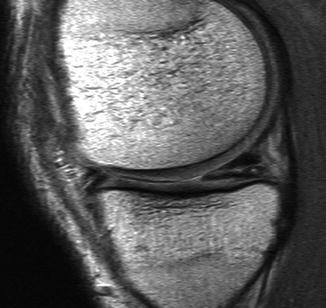

Fig. 21.16
A 35-year-old age group triathlete with anterior knee pain. Sagittal proton density-weighted MRI shows a horizontal flap tear of the posterior horn of the medial meniscus. Arthroscopy and partial meniscectomy was performed. The athlete returned to active sport within 3 months
21.6.5 Plicae
Plicae are normal anatomic structures without a known function. They represent remnants of synovial membrane from embryologic development. They may become symptomatic, resulting in pain and discomfort. (García-Valtuille et al. 2002) Plica syndrome is defined as painful impairment of knee function with a thickened and fibrotic plica. This is thought to be secondary to the hyperflexion position of the knee during extended periods in the aero position. It may be associated with a joint effusion and synovitis. It may also result in erosion about the femoral condyles and/or patellar cartilage damage. Most common plicae include the infrapatellar, suprapatellar, and mediopatellar plicae. The mediopatellar plica most commonly becomes symptomatic (Fig. 21.17) (García-Valtuille et al. 2002; Boles et al. 2004; Dirim et al. 2008; Jee et al. 1998).
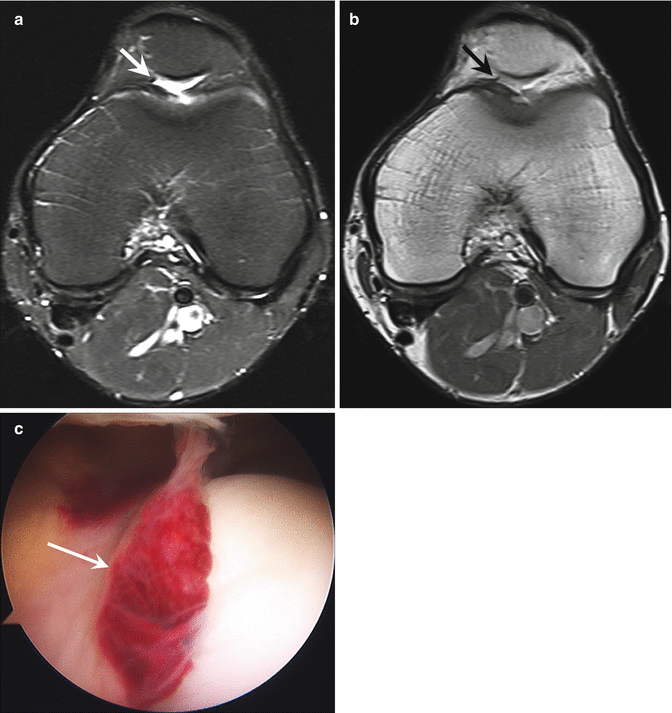

Fig. 21.17
A 28-year-old elite triathlete with anterior knee pain thought to be secondary to long hours in the aero position, clinically thought to be due to a symptomatic plica. (a) Axial fat-suppressed and (b) axial proton density-weighted MRI and (c) arthroscopic image show a thickened, hemorrhagic medial patellar plica (arrow) projecting into the patellofemoral joint. The plica was excised. The athlete recovered completely and competed in the 2013 Ironman World Champs, narrowly missing out on a podium position
21.6.6 Popliteal Artery Entrapment Syndrome
Popliteal artery entrapment syndrome represents a further vascular compression syndrome. It is characterized by compression of the popliteal artery between the two heads of the gastrocnemius muscle. Compression may result in thrombosis with or without distal embolization as well as aneurysm formation. The underlying etiology is anatomic variation in the relationship between the gastrocnemius muscle and the popliteal artery. Six types have been described. Type 3 is the most common, characterized by an abnormal accessory slip of the gastrocnemius muscle (Fig. 21.18) (Eliahou et al. 2012; Kim et al. 2006).
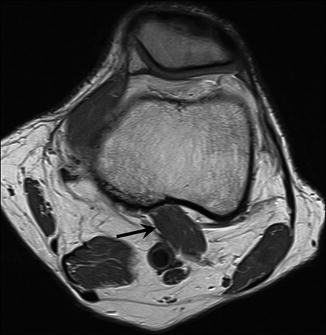

Fig. 21.18
A 32-year-old female triathlete. Axial proton density-weighted MRI shows an anomalous origin of the medial gastrocnemius muscle (arrow) which can result in popliteal artery compression syndrome
21.6.7 Cystic Adventitial Disease
Cystic adventitial disease is characterized by luminal compression secondary to the formation of mucoid cysts in the adventitia (Tomasian et al. 2008). It was first described by Atkins and Key in 1947 and has an incidence of approximately 1 in 1200 of patients presenting with claudication (Wright et al. 2004). Less than 350 cases have been described worldwide. The disease typically affects men between 20 and 50 years without atherosclerotic risk factors. Involvement of the external iliac, femoral, popliteal, radial, and ulnar arteries as well as veins has been described. The popliteal arteries are most commonly affected, involved in approximately 85 % of described cases. It is hypothesized that repetitive adventitial microtrauma may be an etiological factor. Cystic adventitial disease has been described in conjunction with popliteal artery entrapment syndrome, supporting the microtrauma hypothesis (Tomasian et al. 2008; Wright et al. 2004). Athletes present with rapidly progressive calf claudication. Ultrasound and MRI may demonstrate focal cystic lesions in the adventitia with associated luminal narrowing (Fig. 21.19).

